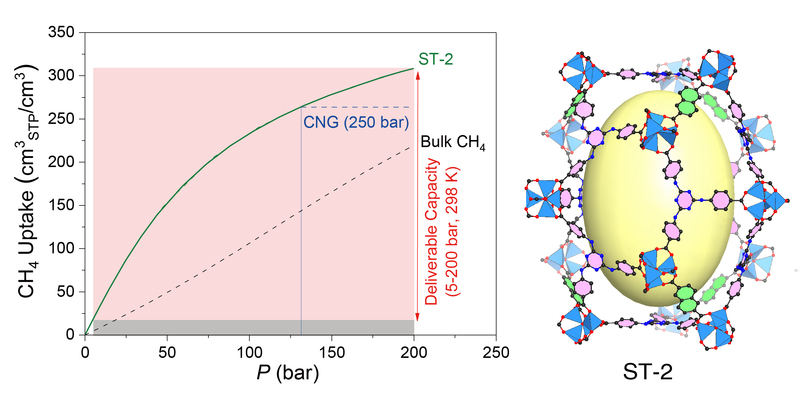Zhang Yuebiao's group in the School of Physical Science and Technology at ShanghaiTech University developed a new series of mesoporous metal organic frameworks (MOFs) and achieved a new record in ultrahigh capacity methane storage. These results have been published in the Journal of the American Chemical Society with the title of “Engineering of Pore Geometry for Ultrahigh Capacity Methane Storage in Mesoporous Metal Organic Frameworks.”
High efficient storage of methane (the main component of natural gas and clathrate hydrate) is the bottleneck to promote the applications of such cleaner fuel in the transportation. Therefore, the use of porous materials in cylinders to increase methane storage capacity, also known as adsorbed natural gas (ANG) technology, has a broad application prospects and commercial value. As crystalline porous materials constructed from inorganic clusters and organic linkers, MOFs possess ultra-high specific surface area, designable frameworks, and adjustable pore metrics, which have been investigated as ANG materials in the past two decades. At present, MOF materials with microporous structures are used to achieve efficient methane storage at lower working pressures (< 80 bar), but their working capacity at room temperature is limited by 208 v/v (5-80 bar) and unable to surpass the traditional compressed natural gas (CNG; 259 v/v, 5-250 bar) technology. This prevents its applications in the environmental- and cost-effective fields like large-scale trucks and long-distance transport.
By introducing fine-turned geometries of mesopore and ultra-high working pressures (<250 bar), Zhang's group scored new achievements in methane storage. In this work, mesoporous MOF materials with Zn4O(-COO)6 units, including UMCM-1, MOF-205 and MUF-7a, and the newly synthesized series MOF materials: ST-1 to ST-4, were investigate for the methane storage under ultra-high pressure, by means of high pressure methane adsorption experiment and theoretical simulation technology. The results showed that ST-2 exhibited the highest methane working capacity (289 v/v, 567 mg/g) in the MOF material at 298 K and 5-200 bar, which also broke the previous record held by a carbon material. In addition, with the help of Professor Yongjin Lee, this work also introduced a big-data technology to quantify the MOF materials’ pore shape and energy distribution correlated to methane adsorption performance. This research constitutes a new approach of machine learning and artificial intelligence for accelerated discovery of porous materials.
The research is supported by the National Natural Science Foundation of China (No. 21522105), and ShanghaiTech University Research Startup Foundation. Determination of single-crystal structures for the newly synthesized ST-MOFs were supported by the staffs in Shanghai Synchrotron Radiation Facility (BL-17B beamline) of the National Center for Protein Science (Shanghai).
Read more at: http://pubs.acs.org/doi/10.1021/jacs.7b08347

The ultrahigh-pressure (0-200 bar) methane isotherms at 298K (left) and X-ray single crystal structure (right) of ST-2


